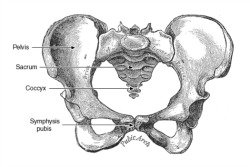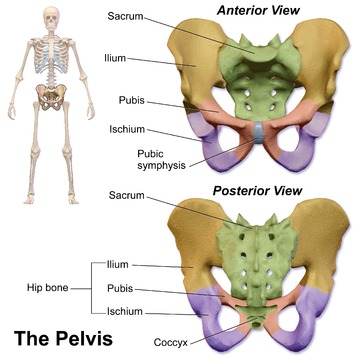Symphysis Pubis Dysfunction SPD Help

This Symphysis Pubis Dysfunction SPD Help page will show you how to relieve pain and tenderness of your symphysis pubis (the front of your pubic bone).
This is a common condition in women who are currently pregnant or have recently given birth. SPD pain is most often caused by inappropriately tight tissue yanking on the joint.
Follow along with the videos below.
Go directly to any Symphysis Pubis Dysfunction SPD Help video on this page with these links:
Intro,
Video 1,
Video 2,
Video 3,
Video 4,
Video 5 .
Click directly to any pain relief video on this page:
Please visit the techniques page now, if you haven't already.
On the homepage I describe…in detail…the 3 Simple Steps and the 4 Basic Facts about your body that make it possible for you to provide your own joint pain relief.
Your pelvis is made up of 3 primary bones. Your Sacrum and your 2 Hip Bones make up the main structure of your pelvis. The Sacrum attaches to your two hip bones (Ilium) in the back at your Sacroiliac Joints. Your two hip bones attach in the front at your Pubic SymphysisPubic Symphysis.
Even though different areas of your hip bones are given different names at the top back (Ilium) in the front of your pelvis (pubis) and at the bottom where your hamstrings and adductors attach (Ischium) they are all still made up of ONE PIECE OF BONE.
When you understand that one mass of bone on each side of your pelvis come together to make your pubic sympysis, then it is easy to understand that any of the many muscles that attach to any area of these hip bones could be inappropriately pulling on the bone and affecting the joint known as your pubic symphysis.
There are many muscle groups that can be affecting the joint, and every person is a bit different in how that inappropriate tension on the pubic symphysis may manifest. So, I'm going to cover all of them and have you investigate which ones are tight in your body. Once your release the inappropriate tension it will be much easier for your symphysis pubis dysfunction to go away immediately or heal much more rapidly.
Click directly to any pain relief video on this page:
1. Release your TFL (Tensor Fascia Latae Muscle) -
Your TFL is located on the side of your hip, right about at the level of your belt. Feel for the top of your hip bone, and then for the top of your femur (thigh bone). Between the these two bones is your TFL.
Lie on your side and place a tennis ball (or other ball) under the muscle. You'll now do the tennis-ball-press technique.
Press the ball into one spot of painful tissue and move your leg to get the tissue being pressed into by the ball to move. When the tissue lets go it will be less painful and more supple. Once it's released you can move the ball to find another tender spot.
Notice how much SPD help this technique provides.
2. Release Gluts and other Hip Rotators
Now take a tennis ball or baseball and do the tennis-ball-press technique on all the muscles of your butt.
I generally start at the bottom and work my way up.
Make sure and do BOTH SIDES of your body. This one technique might reduce your pain immediately if these muscles are really tight and you get them released.
Here's what we're going to do:
We're going to be using the press-pull-release technique and the press-hold-move technique to release the muscles and soft-tissue the attach to the front of your pelvis.
1. Release Iliacus Muscle -
Lie on your back, with your knees up and feet flat on the floor and press your fingertips gently into the side of your lower belly until you find the point of your hip bone known as you ASIS. It's just about directly across from your belly button.
Once you've found your ASIS, move your fingertips in toward your belly button about an inch and then press back into your belly toward your ASIS at about a 45 degree angle so you are pressing on your Iliacus muscle.
Alternate doing the press-pull-release and the press-hold-move techniques until any tender spots you find are released.
2. Release Psoas Muscle -
Find your pubic bone with your fingertips and move up toward your head about 3 inches and out from your belly button about an inch. Gently, press into your abdomin while doing the press-pull-release and the press-hold-move techniques until any tender spots you find are released.
3. Release Front and Top of Pubic Bone -
Press into the front of and the top of your pubic bone with your fingertips and the
press-pull-release and the press-hold-move techniques until any tender spots you find are released.
Notice how much symphysis pubis dysfunction pain relief these techniques provide.
1. Release your Thigh Muscles
Your Rectus Femoris is the biggest strongest muscle in your thigh that connects directly to your hip bone (ilium). It runs right down the center of the front of your thigh. In a sitting position use your thumbs and fingertips to do the press-pull-release technique and press-hold-move technique to get any tight spots to release. The hand-on-hand technique can be a useful addition hear as well.
Notice how much symphysis pubis dysfunction pain relief this technique provides.
2. Release your Vastus Lateralis Muscle and IT Band -
Using the same techniques as you just did on your Rectus Femoris, in a sitting position,
release the outer third of your thigh where you find any tight/painful spots and then release the very side of your leg. You will once again use the press-pull-release technique and the press-hold-move technique to do so.
Notice how much symphysis pubis dysfunction pain relief this technique provides.
3. Release your Hamstrings (back of your upper legs) -
Stand with your feet shoulder width apart with the weight of your body mostly in the balls of your feet. Gently bend forward, and then while flexing your quads are hard as you can, either reach for the ground or reach forward toward the wall at about thigh level. Either way, you should fell the stretch from your calves all the way up to your buttocks.
While bending forward you and also manually work on your hamstrings with your fingertips. Or sit on the floor with your legs spread and reach underneath your leg to work on your hamstrings with your fingertips.
Notice how much symphysis pubis dysfunction pain relief this technique provides.
Here's what we're going to do:
1. Release Your Groin Muscles (Adductors) With Your Hands
Sit on a low stool, bench, chair or cushions with your feet fairly close together and let your knees fall out to the side. Using your thumbs and fingertips do the
2. Release Your Groin Muscles (Adductors) Using Foam Roller or Fist or Ball
Stack up some towels, use a yoga bolster, or some cushions so you can lie on your side
and rest your inner thigh on the cushion. If you have a roller do the press-hold-move on any tender spots you find using the weight your leg to apply pressure to the tight tissue that the bolster is pressing into.
If you don't have a foam roller you can use your fist to press into the tissue. I prefer the pinky side of my fist, but try different ways to see what works for you. A standard softball is a little too firm for my taste, but feel free to try any balls you may have to see what works for you.
3. Release Your Pelvic Floor -
Find the bone on the bottom of your pelvis that you feel if you sit on a hard chair (your sitz bone). Lie on your side and reach your fingertips to the inside of this bone toward your anus. Feel all along the bone for tight tissue.
When you find tight tissue do the press-hold-move and press-pull-release on any tight tissue.
Notice how much symphysis pubis dysfunction SPD help each of these techniques provide.
Are you still experiencing some Symphysis Pubis Dysfunction?
Investigate a bit and you'll eventually find which techniques work best for you to provide the best SPD help for you specifically. Then you'll be able to fix yourself whenever you desire because you'll have your own personalized fSymphysis Pubis Dysfunction exercises and treatment plan, and a pain relief treatment……literally at your fingertips!
To visit the main Pelvic Girdle Pain Relief page (click here)
Copyright © 2011 - 2022 DiyJointPainRelief.com
This short introductory video is a great place to start.
Intro,
Video 1,
Video 2,
Video 3,
Video 4,
Video 5 .
Detailed Instructions For
Symphysis Pubis Dysfunction
SPD Help
Click directly to any pain relief video on this page:
Intro,
Video 1,
Video 2,
Video 3,
Video 4,
Video 5 .
Here's what you want to understand for this SPD help to be effective:
Intro,
Video 1,
Video 2,
Video 3,
Video 4,
Video 5 .
Here's what we are going to do:
Click directly to any pain relief video on this page:
Intro,
Video 1,
Video 2,
Video 3,
Video 4,
Video 5 .
Click directly to any pain relief video on this page:
Intro,
Video 1,
Video 2,
Video 3,
Video 4,
Video 5 .
Here's what we're going to do:
Click directly to any pain relief video on this page:
Intro,
Video 1,
Video 2,
Video 3,
Video 4,
Video 5 .
press-pull-release technique, the press-hold-move technique, and the hand-on-hand technique
to release your inner thigh muscles.
Self-Assessment For
Symphysis Pubis Dysfunction SPD Help
Was there one specific Symphysis Pubis Dysfunction SPD Help exercise that instantly relieved your pain?
Remember what worked best for you, so you can do that first if your SPD ever begins to return.
Which muscles are still tender/painful (that means they are tight!) and could use some more work? These remaining tender spots may be the cause of your SPD.
This Free Pain Relief Website
By Clicking On Your Favorite Icon Below:
Add Gary Crowley to your Google Plus Circles -
Google+ (click here)


